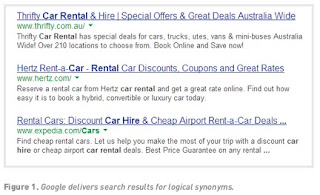Search advertising, also called pay-per-click (PPC) advertising, is a way to advertise your business or product directly on search engine results pages, where the advertiser pays only for each click on their advert.
Search advertising continues to evolve, and formats available range from simple text adverts through to rich media banners and even video adverts. PPC advertising revolutionised the online advertising industry, and today, search advertising generates 95% of Google’s revenue (Peterson, 2013).
Adverts on search engines are easy to spot – they’re clearly labelled as advertising and are separated from organic search results. They can appear on the top of the results page, usually in a box, and also on the right hand side of the results page.
Search advertising on search engines is keyword based – this means that it is triggered by the search term that a user enters into a search engine. Advertisers target the keywords for which they want to appear.
For the advertiser, the beauty of search advertising is that adverts are displayed when potential customers are already expressing intent – they are searching for a product or service. It allows advertisers to present their offering to a potential customer who is already in the buying cycle.
Google is, by a wide margin, the leader in the search advertising field; because of this, the chapter is very Google-centric, though the same principle should apply to any other search advertising platforms. Other platforms to be aware of are Bing,
Yahoo and Baidu.
• How to put together a search advert
• How to target your search ad at relevant users
• The process of bidding on key phrases and how this affects your ranking
• How to plan, set up and run your own search advertising campaign
Search advertising continues to evolve, and formats available range from simple text adverts through to rich media banners and even video adverts. PPC advertising revolutionised the online advertising industry, and today, search advertising generates 95% of Google’s revenue (Peterson, 2013).
Adverts on search engines are easy to spot – they’re clearly labelled as advertising and are separated from organic search results. They can appear on the top of the results page, usually in a box, and also on the right hand side of the results page.
Search advertising on search engines is keyword based – this means that it is triggered by the search term that a user enters into a search engine. Advertisers target the keywords for which they want to appear.
For the advertiser, the beauty of search advertising is that adverts are displayed when potential customers are already expressing intent – they are searching for a product or service. It allows advertisers to present their offering to a potential customer who is already in the buying cycle.
Google is, by a wide margin, the leader in the search advertising field; because of this, the chapter is very Google-centric, though the same principle should apply to any other search advertising platforms. Other platforms to be aware of are Bing,
Yahoo and Baidu.
• How to put together a search advert
• How to target your search ad at relevant users
• The process of bidding on key phrases and how this affects your ranking
• How to plan, set up and run your own search advertising campaign
















